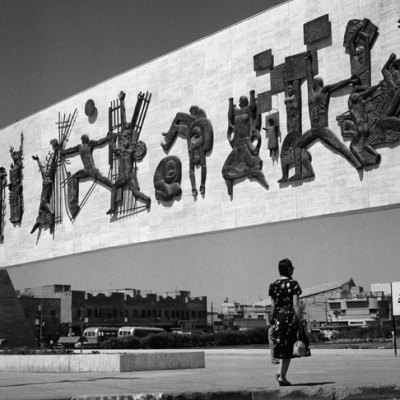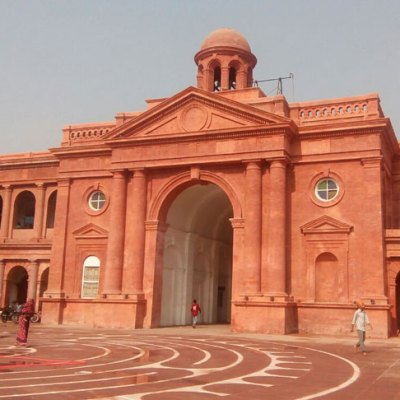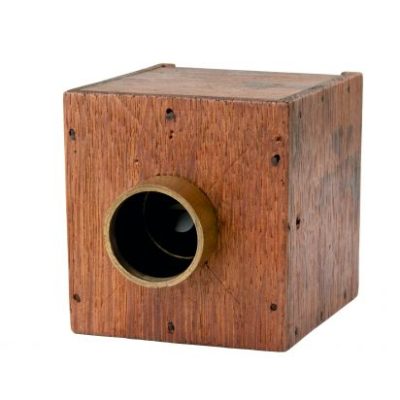On 15 August 1947, 33-year-old photographer Homai Vyarawalla squared her lens on a beaming Lord Mountbatten, his right arm waving over the crowds that had gathered at Parliament House in Delhi. As an employee of the British Information Services, Vyarawalla was no stranger to photographing the British viceroy of India, but this was a uniquely felicitous occasion – after nearly 100 years of Crown rule, India was celebrating its independence from the UK, and Mountbatten was announcing his fast-approaching departure.
Lord Mountbatten among jubilant crowds outside the Parliament House, Delhi, 15 August 1947 (1947), Homai Vyarawalla. © Alkazi Foundation for the Arts

Vyarawalla’s image of Mountbatten hangs three quarters of the way through ‘Illuminating India: Photography 1857–2017’, an ambitious exhibition at London’s Science Museum which is included in its ‘Illuminating India’ season to mark the country’s 70 years of independence. Paired with an exhibition that explores 5,000 years of science and innovation on the Asian subcontinent, the photography survey centres around two key dates: 1857, the year in which an Indian rebellion against the British East India Company resulted in the creation of the British Raj, and 1947, the politically precarious moment that Vyarawalla documented in black and white.
Maharaja Venkat Raman Singh of Rewa (1876–1918) (1899), court photographer. © Alkazi Foundation for the Arts

In an exhibition of this breadth, which unites hand-painted court portraiture, mammoth 19th-century panoramas, misguided anthropological documentation, and a range of other historical and contemporary projects, Vyarawalla’s image might seem somewhat unremarkable – a standard press photograph, formulaic in its depiction of teeming crowds and a foreign dignitary. But its inclusion alongside the best-known contemporaneous press images from India opens up a broad space to consider the work of India’s first female photojournalist – her motivations, her respect for her profession and for those with whom she photographed. Shown alongside Margaret Bourke-White’s LIFE magazine shots of the brutal displacement that occurred after partition borders were drawn, and Henri Cartier-Bresson’s famous images of Mahatma Gandhi, are Vyarawalla’s journalistic images different – and if so, how?
Bara Imambara after the Indian Mutiny, Lucknow, India (mid 19th century), Felice Beato. © Victoria and Albert Museum, London

Curator Shasti Lowton and consulting curator Rahaab Allana (of the Alkazi Foundation for the Arts in New Delhi, which loaned a number of works to the exhibition) foreground the work of local practitioners like Vyarawalla, but deftly bring the work of these photographers into dialogue with their early European (primarily colonially-minded) counterparts. Arranged loosely in chronological order, beginning with the documentation of the Indian mutiny against the East India Company, the earliest prints on display make clear the propagandistic motivations of many European photographers – none better than Felice Beato’s Interior of the Bada Imambada after the Indian Mutiny of 1857. The photograph was taken in 1858, months after the rebellion. The bones strewn about the landscape were almost certainly moved into place for Beato’s image, which would be disseminated back in England to garner political support for the country’s military action.
But as the British harnessed photography to better suit their overseas agendas, Indian photographers working in the latter part of the 19th century began to experiment with formal portraiture, taking cues from the aristocracy of the British Raj. It is with this material that the exhibition gains momentum, displaying a dynamic selection of court portraits, in which each photograph has been hand painted to enhance or amend clothing, backgrounds, or settings, which functioned as status symbols. A series of images by Maharaja Sawai Man Singh II illustrate the prince’s penchant for performative self-portraiture, trading personas and backdrops: one as a Shivabh, another as a bespectacled intellectual.
Self-portrait with studio table (c. 1870), Maharaja Sawai Man Singh II. Maharaja Sawai Man Singh II Museum, City Palace, Jaipur

The exhibition speeds into the middle of the 20th century almost without warning – suddenly the images of Lord Curzon posing with dead Bengal tiger trophies take on the appearance of unintended caricature, especially alongside the increasingly commonplace local studio portraits, marking such occasions as Indian weddings. The detailed wall texts, which help to contextualise the 19th-century images, are not quite as thorough when the exhibition turns to the straight documentary work of the 1940s and ’50s. When we arrive at Vyarawalla’s image of Mountbatten, it raises a number of questions about the day itself: why are the crowds cheering on their former colonial ruler? Without much background information, the scene can be read as a strange contradiction in emotions on a day of independence.
Image from Sweet Life (2017), Sohrab Hura. © Sohrab Hura

But clarity returns as we are ushered into the 21st century. The large format colour work of Raghubir Singh and Mitch Epstein serve as a transition into the contemporary section, where Allana notes that here the exhibition may even subvert its own title by ‘illuminating uncertainties about questions of belonging, representation and agency’ in our increasingly globalised world. The images of Sohrab Hura (Indian), Vasantha Yogananthan (French) and Olivia Arthur (English) are brought together to build upon the vast historical, photographic canon laid out before them. The series of works, hugely different in subject matter and execution, are all linked in their return to the private sphere, a new focus on intimacy and privacy. Before she died in 2012, Vyarawalla was asked why she took up photography. She answered, ‘It’s just a job’. For contemporary photographers working in India today, it seems their answer to the same question might be a little more complex.
‘Illuminating India: Photography 1857–2017’ is part of the Science Museum’s ‘Illuminating India’ season, which runs until 31 March 2018.



